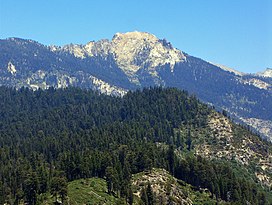| Alta Peak | |
|---|---|
 West aspect, from Moro Rock | |
| Highest point | |
| Elevation | 11,208 ft (3,416 m) NAVD 88[1] |
| Prominence | 124 ft (38 m)[2] |
| Listing | Sierra Peaks Section[3] |
| Coordinates | 36°35′26″N 118°39′48″W / 36.590579589°N 118.663385947°W[1] |
| Geography | |
| Location | Tulare County, California, U.S. |
| Parent range | Sierra Nevada |
| Topo map | USGS Lodgepole |
| Climbing | |
| First ascent | 1896 by William R, Dudley[4] |
| Easiest route | Hike, class 1[3] |
Alta Peak is in Sequoia National Park not far from Giant Forest. Before 1896, the mountain was known as Tharps Peak. By 1903 it was generally known by its current name and Alta Peak appears on the Tehipite quadrangle, USGS 30 minute topographic map of 1905,[5] and was officially recognized by the Board on Geographic Names in 1928.[6] The Sierra Club Bulletin noted that the name Alta Peak was "euphonious". A meadow on its southern slope had long been known as Alta Meadow.[7] A rocky outcrop, 0.5 miles (0.8 km) southwest of the summit, is now known as Tharps Rock. Hale Tharp was the first euro-American to explore the Giant Forest area. His summer camp, a hollowed out Sequoia log near Crescent Meadow known as Tharp's Log, is popular with park visitors.
References
[edit]- ^ a b "Alta". NGS Data Sheet. National Geodetic Survey, National Oceanic and Atmospheric Administration, United States Department of Commerce. Retrieved 2016-03-24.
- ^ "Alta Peak, California". Peakbagger.com. Retrieved 2016-03-24.
- ^ a b "Sierra Peaks Section List" (PDF). Angeles Chapter, Sierra Club. Retrieved 2016-03-24.
- ^ Secor, R.J. (2009). The High Sierra Peaks, Passes, and Trails (3rd ed.). Seattle: The Mountaineers. p. 90. ISBN 978-0898869712.
- ^ Tehipite quadrangle, California (Map). 1:125000. 30 Minute Topographic. USGS. 1905. Retrieved 2021-11-02 – via USC Digital Library.
- ^ "Alta Peak". Geographic Names Information System. United States Geological Survey, United States Department of the Interior. Retrieved 2016-03-24.
- ^ Browning, Peter (1986). Place Names of the Sierra Nevada. Berkeley: Wilderness Press. pp. 4, 214. ISBN 978-0-89997-119-3.



Well, that’s interesting to know that Psilotum nudum are known as whisk ferns. Psilotum nudum is the commoner species of the two. While the P. flaccidum is a rare species and is found in the tropical islands. Both the species are usually epiphytic in habit and grow upon tree ferns. These species may also be terrestrial and grow in humus or in the crevices of the rocks.
View the detailed Guide of Psilotum nudum: Detailed Study Of Psilotum Nudum (Whisk Fern), Classification, Anatomy, Reproduction